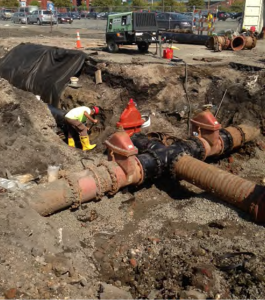
Traditional infrastructure, such as sewer treatment plants and below-the-ground infrastructure, takes raw sewage and water to a sewage plant for treatment; this is referred to as “gray infrastructure.” Gray infrastructure solutions to help reduce CSOs include:
Sewer line maintenance and repairs
Cleaning pipes creates more room for sewage and stormwater. Fixing leaks reduces groundwater coming into pipes.
Disinfection
This involves installing a device that releases a disinfectant into sewage before it overflows.
Increasing capacity at sewage treatment plants
This creates more room to treat sewage and stormwater at the plant so overflows happen less frequently.
Underground storage tanks and tunnels
This creates a place for the stormwater and sewage to go until there’s room for it at the treatment plant.
Sewer separation
This makes two lines—one for sewage, which goes to the treatment plant, and one for stormwater, which drains directly into nearby waterways. Keeping stormwater out of the sewage treatment plant means the plant is never overwhelmed when it rains.
